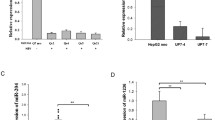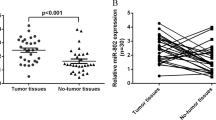Summary
This study aimed to construct the dual-gene expression vector pHsa-miR16-siRNA which can express human miR-16 and HBV X siRNA, and examine its regulatory effect on HBV gene expression in the HepG2.2.15 cell line. The expression vectors siR-1583 and pHsa-miR16-siRNA were designed and constructed. HepG2.2.15 cells were transfected with the empty vector, siR-1583, pmiR-16 and pHsa-miR16-siRNA, respectively. ELISA was performed to measure the expression of HBsAg and HBeAg in the culture supernatant 48 and72 h post transfection. Fluorescence quantitative PCR was used to measure the HBV mRNA degradation efficiency and HBV DNA copy number. The results showed that the expression of HBV genes was significantly inhibited in HepG2.2.15 cells transfected with siR-1583, pmiR-16 and pHsa-miR16-siRNA, respectively, when compared with that in cells transfected with the empty vectors, with the inhibitory effect of pHsa-miR16-siRNA being the most significant. ELISA showed that the inhibitory rates of HBsAg and HBeAg in pHsa-miR16-siRNA transfected cells were correspondingly 87.3% and 85.0% at 48 h, and 88.6% and 86.5% at 72 h post transfection (P<0.01 vs. control group). RT-PCR showed that the level of HBV mRNA decreased by 80.2% (t=–99.22, P<0.01), the genomic HBV DNA by 92.8% (t=–73.06, P<0.01), and the supernatant of HBV DNA copy number by 89.8% (t=–47.13, P<0.01) in pHsa-miR16-siRNA transfected group. It was suggested that the dual-gene expression vector pHsa-miR16-siRNA can inhibit the replication of HBV more efficiently than a single-gene expression vector.
Similar content being viewed by others
References
WHO 2013 Hepatitis B Virus Fact Sheet No. 204 (Updated July 2013)
Zoulim F, Durantel D. Antiviral therapies and prospects for a cure of chronic hepatitis B. Csh Perspect Med, 2015,5(4):a021501–a021501
Gish R, Jia JD, Locarnini S, et al. Selection of chronic hepatitis B therapy with high barrier to resistance. Lancet Infect Dis, 2012,12(4):341–353
Bouchard MJ, Puro RJ, Schneider RJ, et al. Activation and inhibition of cellular calcium and tyrosine kinase signaling pathways identify targets of the HBx protein involved in hepatitis B virus replication. J Virol, 2003,77(14):7713–7719
Zhang XD, Wang Y, Ye LH. Hepatitis B virus X protein accelerates the development of hepatoma. Cancer Biol Med, 2014,11(3):182–190
Deng WY, Lu MJ. The role of microRNAs in hepatocyte metabolism and hepatitis B virus replication. Virologica Sinica, 2016,31(6):472–479
Zhang XY, Yu B, Lv TT, et al. Construction and identification of eukaryotic expression vector of miR-16. J Mol Biol, 2008,5(1):31–34
Morrissey DV, Lockridge JA, Shaw L, et al. Potent and persistent in vivo anti-HBV activity of chemically modified siRNAs. Nat Biotechnol, 2005,23(8):1002–1007
Wen WH, Liu JY, Qin WJ, et al. Targeted inhibition of HBV gene expression by single-chain antibody mediated small interfering RNA delivery. Hepatology, 2007,46(1):84–94
Brummelkamp TR, Bernards R, Agami R. A system for stable expression of short interfering RNAs in mammalian cells. Science, 2002,296(5567):550–553
Acharya R, Saha S, Ray S, et al. siRNA-nanoparticle conjugate in gene silencing: A future cure to deadly diseases? Mat SciEng C-Mater, 2017,76:1378–1400
Barik S. Silence of the transcripts: RNA interference in medicine. J Mol Med, 2005,83(10):764–773
Klemm V, Mitchell J, Cortezjugo C, et al. Achieving HIV-1 control through RNA-directed gene regulation. Genes, 2016,7(12):119
Hou Z, Quan J. Hepatitis B virus X protein increases microRNA-21 expression and accelerates the development of hepatoma via the phosphatase and tensin homolog/phosphoinositide 3-kinase/protein kinase B signaling pathway. Mol Med Rep, 2017,15(5):3285–3291
Carmona S, Ely A, Crowther C, et al. Effective inhibition of HBV replication in vivo by anti-HBx short hairpin RNAs. Mol Ther, 2006,13(2):411–421
Wu G, Yu F, Xiao Z, et al. Hepatitis B virus X protein downregulates expression of the miR-16 family in malignant hepatocytes in vitro. Brit J Cancer, 2011,105(1):146–153
Khokhar A, Noorali S, Sheraz M, et al. Computational analysis to predict functional role of hsa-miR-3065-3p as an antiviral therapeutic agent for treatment of triple infections: HCV, HIV-1, and HBV. Libyan J Med, 2012,7(1):19774
Author information
Authors and Affiliations
Corresponding author
Additional information
This work was supported by grants from the Independent Innovation Research Fund of Huazhong University of Science and Technology (No. 2016YXMS200), and Natural Science Foundation of the Science and Technology Department of Hubei Province (No. ZRMS2017000406).
Rights and permissions
About this article
Cite this article
Wei, W., Wang, Sf., Yu, B. et al. Inhibition of HBV replication by delivering the dual-gene expression vector pHsa-miR16-siRNA in HepG2.2.15 cells. CURR MED SCI 37, 828–832 (2017). https://doi.org/10.1007/s11596-017-1810-0
Received:
Revised:
Published:
Issue Date:
DOI: https://doi.org/10.1007/s11596-017-1810-0




